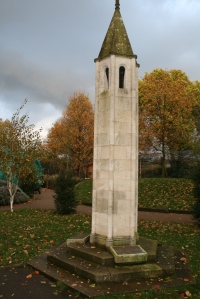
19 zoo staff were lost as a result of active service during and after WW1 from the now vanished Belle Vue Zoo in Manchester.
Since 2009 I have been researching the wartime effects on a few typical British zoos operational in the First World War and what that generation learnt in preparation for surviving the Second World War (when our recreated World War Zoo Gardens dig for victory garden project at Newquay Zoo is set).
The few zoo war memorial records found so far stand in for a whole generation and for lost zoological gardens staff across the world.
Previously we have researched and posted about the 12 lost WW1 staff on the ZSL London Zoo staff memorial, where wreaths will be laid each year during the Armistice and Remembrance silences:
https://worldwarzoogardener1939.wordpress.com/2013/11/04/remembering-lost-wartime-staff-of-zsl-london-zoo-in-ww1/
Belle Vue Zoo War Memorial
This year in the 1915 centenary year, spare a thought for the 19 fallen staff of Belle Vue Zoo Gardens in Manchester (which closed 1977/78), their names listed on a vandalised zoo staff war memorial in Gorton Cemetery.
Reading the names means these men are not forgotten.
Read the names and spare a thought for these 19 lost Belle Vue Zoo staff from the First World War.
Researching and reading a few of these background stories puts a more personal face on the scale of the losses, especially in the First World War.
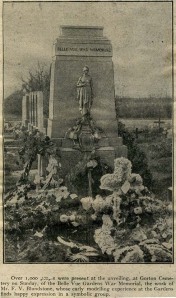
- Belle Vue’s war memorial, Gorton Cemetery, Manchester on its unveiling 1926. Image: manchesterhistory.net
The Belle Vue Zoological Gardens staff war memorial at Gorton cemetery in Manchester is now sadly vandalised and missing its bronze statue by sculptor Ferdinand Victor Blundstone, one of of his several memorial designs.
The now missing Blundstone statue was cast by Parlanti. The memorial’s damaged condition is now noted on the UKNIWM UK National Inventory of War Memorials.
The Belle Vue Zoo war memorial was unveiled in Gorton Cemetery by members of the Jennison family in 1926, who had owned the zoo from its Victorian roots until the year before. The Jennisons had lost two sons (and future managers or directors?) in the First World War.
Much has been written about Belle Vue as an early zoo and leisure gardens collection, which survived from the 1836 to 1977/8 such as this extensive Belle Vue Zoo Wikipedia entry and several books and films by Robert Nicholls. Its records are held in the Chetham’s Library Archive and now being scanned for public access.
Spare a thought for the Belle Vue men listed on the monument and their families.

Beautifully sunny photo of the Belle Vue Zoo war-memorial. Image source: Stephen Cocks’ Tommy at War blog site
I first came across the memorial through the 1926 original press articles from its dedication at http://manchesterhistory.net/bellevue/warmemorial.html
Stephen and Susan Cocks’ Tommy at War 2010 blog entry The Belle Vue Monument (or Memorial) expanded on some of the the personal casualty information available on the cwgc.org website https://gbt01.wordpress.com/2010/02/04/the-belle-vue-memorial-the-story-of-the-memorial/
https://gbt01.wordpress.com/2010/01/15/hello-world/
Since these first 2010/11 postings by Stephen Cocks and my research on this website, members of the Manchester and Salford Family History Forum have furthered the research locally and produced a fascinating section of their website on Gorton Cemetery, its war graves and the Belle Vue war memorial staff casualties and their families:
http://gortonphilipsparkcemetrywargrave.weebly.com/belle-vue-war-memorial.html
So who were these Belle Vue men?
Belle Vue Zoological Gardens staff killed on active service 1915-1918
Belle Vue Zoo staff 1915 deaths
1. Private Henry Mulroy Served as Private 23516 in the 12th Battalion, Manchester Regiment, killed at Ypres on 16 August 1915, whilst his battalion were holding trenches to the south of Ypres.
Henry had only been in France for one month before he was killed. Another Manchester Regiment casualty from his 12th Battalion, Private 4970 J Mullen lies alongside Mulroy, killed on the same day.

Mulroy’s grave lies among these at Ridge Wood Military Cemetery, Ypres, Belgium.
Image: cwgc.org
Mulroy was remembered in a blogpost on the centenary day of his death: https://worldwarzoogardener1939.wordpress.com/2015/08/16/remembering-h-mulroy-belle-vue-zoo-died-ypres-16-august-1915/
Mulroy is buried in an individual grave I.I.5 in Ridge Wood Military Cemetery, to the South-west of Ypres, Belgium (Flanders). Ridge Wood was the name given to a wood standing on high ground between the Kemmel road and Dickebusch Lake. The cemetery lies in a hollow on the western side of the ridge and the position was chosen for a front line cemetery as early as May 1915. The cemetery, designed by Sir Edwin Lutyens, contains 619 Commonwealth burials of the First World War.
Martin and Mary Middlebrook’s book on The Somme Battlefields (Penguin 1991) mentions that Mulroy’s battalion the 12th Manchesters have a special tall memorial stone near Contalmaison Chateau Cemetery, commemorating the 555 casulaties from 3rd – 6th July 1916 at the Battle of the Somme and overall the 1039 men such as Mulroy (a 1915 casualty) who died in the war. This number, Middlebrook says, is the “exact equivalent of the number of men who sailed from England with the original battalion in July 1915” including Henry Mulroy. His Medal record card records this date of embarkation.
The 12th Manchester history website sets out Mulroy’s likely military journey from when the 12th (Service) Battalion formed at Ladysmith barracks, Ashton-under-Lyne in September 1914 of “Kitchener volunteers”. The battalion then moved south to Bovington camp, Wool in Dorset as part of 52nd Brigade, 17th Division, an invasion of Northern troops to rural Dorset. In January 1915 they moved to Wimborne in Dorset then in February 1915 back to hutments in the Wool area.
More on Mulroy’s 12th Manchester life in Bovington camp, Wool (now the site of the Bovington Tank Museum) can be read in the downlodable pdf of Chapter II / 2 of G.E. Lanning’s Bovington Garrison. By May 1915 they moved to Hursley Park, near Winchester where they stayed until embarkation from Folkestone on 15th July 1915.
On the morning of the 16th July 1915, 30 officers and 975 men of the 12th (Service) Battalion Manchester Regiment landed at Boulogne, moving on to be attached to the Liverpool Scottish for training in trench warfare at Ouderom around the 21st July 1915. The 12th Battalion first went into the line on the 24th July 1915 near Vierstaat and later SE of St Eloi. “For the rest of the year they were in and out of the frontline around Ypres”, the Manchester Regiment website notes of the period when Mulroy was killed. The 12th Battalion Manchester Regiment War Diary gives great detail of the Mulroy’s battalion movements and states around the period of Mulroy’s death a possible cause for his death:
15/8/1915 Quiet day; Some artillery activity in afternoon on both sides. Heavy rifle and machine gun fire during the night.
16/8/1915 Enemy fired rifle grenades on trench No 5.
17/8/1915 Very quiet day. Were relieved by the 9th Bn Duke of Wellington Regt. Relief commenced at 8.0pm but did not complete until 4.30am of the 18th inst owing to furious bombardment by the enemy.
Mulroy was in the 12th Manchester (Service) Battalion, so likely to have been one of Kitchener’s volunteers. On 7th Aug three days after war was declared, a recruiting poster and notices in the newspapers called for 100,000 men aged between 19 and 30 to the Army, serving for three years or the duration of the war. Within a few days the “First Hundred Thousand” had joined up. By the middle of September 1914, half a million men like Henry Mulroy had enlisted. Many of Mulroy’s battalion died in the Somme battles of 1916 where the New Army battalions suffered terrible losses.
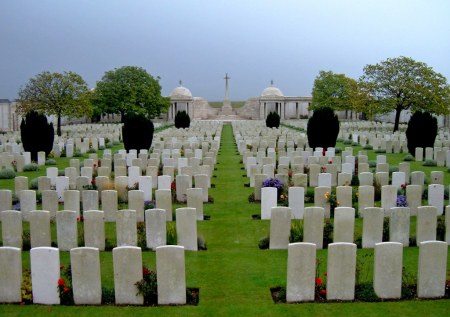
Loos Memorial
(Image: CWGC website)
2. Private Frederick Lester Reid,
Private Frederick Lester Reid served in the 1st Battalion of The Loyal North Lancashire Regiment.
This regular battalion was one of the first to land in France in August 1914 and had been present at The Battle of Mons. He was killed at the age of 31 on 25 September 1915.
The 1st Loyal North Lancashire Regiment were part of The 1st Division which suffered heavily in the attack on the first day of the Battle of Loos. Initially caught in their own first British use of gas, they moved forward as the gas cleared and finding that the German wire was uncut, suffered heavily as they attempted to cut through it in the face of German machine gun fire.
Private Reid has no known grave and is commemorated on The Loos Memorial to the Missing.
He was remembered on the centenary of his death in our Loos blogpost: https://worldwarzoogardener1939.wordpress.com/2015/09/26/gardeners-and-zoo-staff-lost-at-the-battle-of-loos-25-september-1915/
Private Reid was married to Jessie and lived at 256 Gorton Road, Reddich.

Reid’s name is amongst the many on the Loos Memorial. Image: cwgc.org website
As we approach the centenary of each casualty, we shall mark the day and research each casualty further on this blog. interesting information has emerged about William Morrey’s unusual service and death several days before the Battle of the Somme.
Belle Vue Zoo staff 1916 deaths
3. Private William Morrey, Several William Morreys from the Cheshire, Lancashire and Manchester area are listed on the cwgc.org site, obviously a local name.
Before his enlistment under the Derby Scheme, it appears our William was the one who worked as a water and gas fitter at the Zoological Gardens at Belle Vue, Manchester.
Pioneer 130519 William Morrey died aged 21 on the 27 June, 1916, serving originally with the Manchester Regiment but on his death with the 1st Battalion of the Special Brigade, Royal Engineers (a gas unit).

William Morrey is buried in the middle of the second to back row of these hospital related casualties, Beauval Communal Cemetery, Somme, France.
Morrey is buried at an individual grave B17 at Beauval Communal Cemetery, Somme, France. The great majority of the burials were carried out from such hospitals as the 4th Casualty Clearing Station where Morrey died at Beauval from June 1915 to October 1916.

Directly alongside Morrey in three other graves B 14-16 are three others of this special Battalion killed on the same day, Pioneer 129027 Richard Brown, Pioneer 128027 James Duckett (also from Manchester) and Pioneer 128805 Walter Norman Welton.
CWGC lists Morrey as the son of William and Lydia Morrey, of Widnes. Mr A.E. Morrey of 13 Ollier Street, Widnes, Lancs appears to have chosen the family inscription on his CWGC headstone: “He gave his life for Freedom”

Morrey and comrades lie in the middle of the second to back row of Beauval Cemetery, France. Image: cwgc.org
These Special Companies are described on the Long, Long Trail website http://www.1914-1918.net/specialcoyre.htm and on their forum posts #61 Royal Engineers Special Brigade: post #61 jones75 which gives the following information:
Pioneer William Morrey, No.130519, 21st Section, 1st Bn, Special Brigade, Royal Engineers
Born : Widnes, Lancashire.
Enlisted : Manchester, 20th January, 1916.
Resided : The Lodge, Halton View, Widnes.
Died of wounds in France on 27th June, 1916, aged 21.
Buried at Beauval Communal Cemetery, Row B, Grave 17.
William Morrey is also commemorated at St Ambrose church in Halton View, the Belle Vue Zoo memorial and on the Widnes War Memorial in Victoria Park, Widnes in Cheshire.
William Morrey was the second son of William & Lydia Morrey and died in No.4 Casualty Clearing Station on the 27th June as result of gas poisoning on the previous day.
His sister, Mrs Dutton of Milton Road, Widnes, received a letter from an Army Chaplain, Reverend H.D.W. Dennison, CF, in it he wrote….”It is with deep regret that I have to tell you of the death of your brother, Pioneer W. Morrey. He was admitted into this hospital yesterday afternoon suffering severely from gas poisoning, and though everything possible was done for him, he died early this morning. I am burying him this afternoon with four of his comrades who suffered the same fate in Beauval Cemetery. May he rest in peace and, and may God comfort sad hearts that his loss will cause……”
An old boy of Simms Cross school, William Morrey also attended St Ambrose church and Sunday School and was a member of the Gymnasium at St Paul`s Parochial Rooms. On leaving school, he worked for five years as an apprentice gas & water fitter at the Corporation Gas Works in Widnes.
Before his enlistment under the Derby Scheme he worked as a fitter at the Zoological Gardens at Belle Vue, Manchester.
He joined up on 20th January, 1916 into the 14th Bn, The Manchester Regiment, regimental number 32486 and in March that same year was transferred to the Royal Engineers and sent to France.
He wrote his last letter home in mid June and in it he said he was in the best of health and expected to be moved nearer to the front line. (WWN 1916)
The Special Brigade, Royal Engineers was a unit formed to counter the German Gas threat, they were employed to dispense poison gas from the allied trenches towards the enemies lines, it is possible that William Morrey was gassed carrying out this task as accidents and the effect of shell-fire on the equipment caused leaks on a regular basis.
So Morrey died in the preparation for the Somme, which three months later would claim another Belle Vue Zoo colleague, Alfred Routledge.

Routledge is one of several British zoo staff with no known grave who are remembered on the Thiepval Memorial (Image: CWGC website)
4. Private Alfred Routledge
He died serving with the 11th Battalion Manchester Regiment on The Somme aged 23 on 26 September 1916. He was killed in an attack on Mouquet Farm which was part of the final and successful British attempt to capture the village of Thiepval.
The village occupied high ground in the centre of the battlefield and had been a British objective on the first day of The Battle of The Somme on 1 July 1916.
Alfred Routledge is one of the many “Missing of the Somme” listed on the Thiepval memorial, having no known grave. Routledge was killed in the final days of taking Thiepval village, one of the original objectives of the 1st July 1916, the first disastrous day of the Battle of The Somme two months earlier.
CWGC lists him as the son of the late Alfred and Emily Barton Routledge of 504 Gorton Lane, Gorton. Married.
Routledge and fellow Belle Vue Zoo staff Sidney Turner and Ralph Stamp are remembered on the St. James Parish Church war memorial http://gortonphilipsparkcemetrywargrave.weebly.com/st-james-church-gorton.html
Belle Vue Zoo staff 1917 deaths
5. Second Lieutenant James Leonard Jennison
James Leonard was the son of James Jennison, one of the two Jennison brothers who owned Belle Vue Zoo. His father James died later that year, possibly hastened by this family loss. His cousin Norman, son of Angelo Jennison, also died on active service in Italy.
Second Lieutenant James Leonard Jennison served in the 15th Battalion of The West Yorkshire Regiment, the Leeds Pals. He was killed at Arras on 3 May 1917. He has no known grave and is commemorated on the Arras Memorial to The Missing.
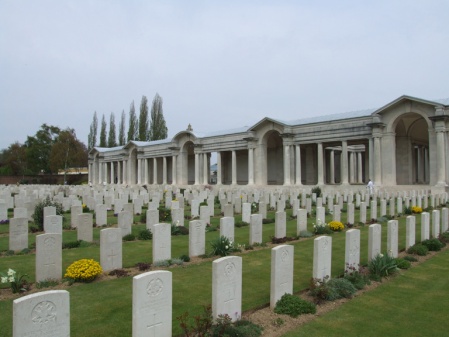
2nd Lieutenant James Jennison and Private William Stamp of Belle Vue Zoo Manchester have no known grave are remembered on the Arras Memorial
(Image: CWGC website)
6. Private Ralph William Stamp, 18th battalion, Manchester Regiment, died aged 23, on the 23rd April 1917, and has no known grave, listed on the Arras memorial, the same as J L Jennison.
Private Ralph William Stamp was the son of Robert and Jane Stamp of 36 Newton Street, Gorton. He was killed in The Battle of Arras aged 23 on 23 April 1917, serving as a member of the 18th Battalion of The Manchester Regiment. Stamp has no known grave, so is commemorated on The Arras Memorial to the Missing. He is also remembered on the St James Church Gorton war memorial.
He appears to have been on the gardens staff.

Sergeant Oliver is listed amongst the 35,000 names on the Tyne Cot memorial to the missing. Image: cwgc.org
7. Sergeant John E. Oliver
John Oliver served with the 21st Battalion, Manchester Regiment and he was killed on 24 October 1917 towards the end of the ‘Battle of Passchendaele’ (The Third Battle of Ypres) from July 31st to November 6th 1917.
By October during the last phases of the battle, the battlefield had become a sea of mud. It was in this fighting, finally achieving the objective of capturing the village of Passchendaele itself, that Sergeant Oliver was killed.
John Oliver has no known grave and is commemorated on The Tyne Cot Memorial to the Missing.
Sergeant John Oliver was the husband of Rose Oliver of 36 Darley Street, Gorton. He appears to have been a journeyman joiner by trade.

Thomas Tumbs’ name on Panel 22 of the WW1 section of the Plymouth Naval Memorial. Image Source: Mark Norris, Newquay Zoo, November 2015.
8. Stoker First Class T J Tumbs, AB
Died aged 40, killed on HMS Drake, 2 October, 1917, on convoy duty off coast of Ireland in U79 U-boat torpedo attack.
Remembered on the Plymouth Naval Memorial, Stoker First Class Tumbs was aged 40 and one of 19 sailors killed aboard the cruiser HMS Drake when it was torpedoed by German U Boat U79 on 2 October 1917.
Attacked while escorting an incoming Atlantic Convoy, the ship limped into Church Bay off the coast of Ireland where it sank and still provides a wreck popular with divers.
As he has no known grave, being lost at sea, his name is remembered on Panel 22 of the Plymouth Naval Memorial, which I visited recently on a suitably wet and blustery day.
9. Private Harold? Heathcote, 5th Battalion, Wiltshire Regiment died in Mesopotamia (modern Iraq), 19 October 1917, buried Baghdad war cemetery.
Private H. Heathcote is probably Private Harold Heathcote of Openshaw, who died in Mesopotamia (modern Iraq) on 19 October 1917 while fighting The Turks with The 5th Battalion of The Wiltshire Regiment. Private Heathcote is buried in The Baghdad War Cemetery.
Belle Vue Zoo staff 1918 deaths
10. Sergeant J Fuller, Devonshire Regiment / Pioneer Corps, died 14 April 1918. Buried Amiens, France. Married.
On March 1918 The Germans launched the first of their offensives in a final bid to win the war. The British bore the brunt of these offensives in March and April and, although the British were forced to concede considerable ground, the line never broke.
Sergeant Fuller was married and lived at 9 Millen Street, West Gorton.
He was serving with the Labour Corps, having transferred from The Devonshire Regiment, possibly as a consequence of being wounded. He died on 14 April 1918 and is buried in St Pierre Cemetery, Amiens town was a key objective of the German offensive but never fell.

Keeper James Craythorne’s grave lies just in front of the Cross of Sacrifice in this tiny French cemetery of 141 graves. Image: cwgc.org
11. Private James George Craythorne, 1/6 Manchester Regiment, killed 20 October 1918 ironically in the fighting for Belle Vue Farm, buried at Belle Vue (Farm) Cemetery, France.
Zoo Keeper James Craythorne is one of 66 1st /6th or other Manchester Regiment casualties in the cemetery from the 20th October 1918. This ‘Belle Vue’ cemetery was named after a farm captured by The 42 East Lancashire Division, of which Private Craythorne was a member.
Three or four generations of the Craythorne family worked as small mammal and reptile keepers at Belle Vue Zoo, including James Craythorne who followed his own father into zoo work, was employed aged 12 from the 1880s to retirement during another war in 1944, replaced then by his son Albert!

Gorton Cemetery’s Cross of Sacrifice, a focus for the CWGC graves including William Turner’s. Image: cwgc.org
12. Private Sidney Turner,
Sydney or Sidney Turner died in the UK aged 18, 3rd May 1917 serving as TR4/13456 in a reserve battalion (20th) of the Welsh Regiment, buried in Gorton Cemetery (near the site of the Belle Vue Zoo war memorial).
Several others who died after the war are also individually buried here in Gorton Cemetery.
The youngest soldier listed, he was the son of Thomas and Mary Turner of 58 Pinnington Road Gorton. His mother chose the headstone inscription: “Sadly Missed”.

Many of those buried in the cemeteries and churchyards of the city died in Manchester or nearby hospitals. An intriguing note on the CWGC graves register sheet suggested his original ‘private grave / grass mound’ was ‘neglected’ and that he died at Kinmel Park Military Hospital at Kinmel Park Army Camp, Abergele, Wales. The crossed out ‘Rly’ note may refer to the Kinmel Camp Railway: https://en.m.wikipedia.org/wiki/Kinmel_Camp_Railway
There are 69 First World War casualties / burials scattered throughout the Gorton cemetery and a Screen Wall bears the names of 15 First World War casualties (including Turner?) whose graves could not be individually marked. The Manchester and Salford Family History Forum website has more about this memorial and casualties: http://gortonphilipsparkcemetrywargrave.weebly.com

Sidney / Sydney Turner’s name can be glimpsed on the top of the plaque of this CWGC memorial in Gorton Cemetery, Manchester. (Image: CWGC)
13. Captain Norman L Jennison, MC (Military Cross) , 6th Manchester Regiment (Territorials), died of flu, Genoa, Italy 30 October 1918
Norman Jennison was the son of Angelo Jennison, one of the two Jennison brothers who owned Belle Vue zoo, and lived at 49 East Road Longsight.
Norman was a clerk and had joined the 6th Manchesters, a territorial battalion, before the war as a private.
Commissioned in 1916, he was attached to a trench mortar battery and served in Italy from October 1917, where he died of flu on 30 October 1918.

The Cross of Sacrifice and Row A & B in the terrace above Jennison’s Row D grave, Staglieno Cemtery, Genoa, Italy.
Image: cwgc.org
He is buried amongst the 230 First World War graves on the dramatically terraced Staglieno Cemetery in Genoa, Italy. His cousin James Leonard also died on active service.

Norman Jennison’s grave lies in the middle of this second row (D) from the right amid dramatic mountain scenery, Staglieno Cemetery, Genoa, Italy. Image: cwgc.org
The Italians entered the war on the Allied side, declaring war on Austria, in May 1915. Commonwealth forces were at the Italian front between November 1917 and November 1918, and rest camps and medical units were established at various locations in northern Italy behind the front. Genoa was a base for commonwealth forces and the 11th General, 38th and 51st Stationary Hospitals, possibly where Jennison died.
Belle Vue Zoological Gardens staff “who died from the effect of war” after 1918.

- Zoo owner Angelo Jennison unveiling in 1926 the Belle Vue memorial in Gorton Cemetery to his son, nephew and his zoo staff lost in the First World War. Image: manchesterhistory.net
This unusual addition or section of names gives a little glimpse of what must have happened to many zoo, aquarium and botanic garden staff who never recovered from the effects of active service in wartime.
14. Private WM Wheatcroft, 3rd Battalion, Kings Liverpool Regiment, died aged 28, 10 July 1919, buried in Gorton cemetery.
Private WM Wheatcroft served in The 3rd Battalion of The Kings(Liverpool) Regiment. He was the son of Sarah and Jessie Wheatcroft and died aged 28 on 10 July 1919. He is buried in Gorton Cemetery and at the time of his death his widowed mother had remarried and lived at 5 Bakewell Street Gorton.
Wheatcroft appears to have been on the Belle Vue gardening staff.
15. Sergeant Robert Hawthorne, died 24 June 1922, buried in Gorton cemetery alongside Belle Vue casualty Joseph Cummings.
16. Rifleman / Lance Corporal William Croasdale, Belle Vue’s baker, served Army Service Corps (bakery) and Kings Royal Rifle Corps, served overseas 1915 to 1919, aged 32, died 1922, (possibly Stephen Cocks suggests in a mental hospital, Prestwich).
William Croasdale is listed as having died from the effects of war and his history is far from uncommon for men who actually survived the fighting, but never the less still had their lives destroyed by the war.
His service record has survived and, as shown in Stephen Cocks’ Tommy at War blog, it gives a fascinating account of his life and army servive.
William Croasdale was living at 536 Gorton Road in Reddish when he enlisted into the army on 5 November 1914. He is described as 5 feet 6 inches tall, with blue eyes, fair hair and a fresh complexion. He was a baker at Belle Vue and his record actually includes a reference from James Jennison.
William was enlisted into the Army Service Corps as a baker and was posted abroad in May 1915 and, apart from 14 days leave in 1918, he served overseas until March 1919. William’s service was transformed dramatically in 1916 when he was compulsorily transferred to The Kings Royal Rifle Corps.
Apart from minor infringements of discipline, including being found in possession of dirty bombs (grenades) and returning a day late from leave, his record is a good one and he was promoted to lance corporal in 1918.
He returned from the war, but he died aged 32 in 1922 in Prestwich.
17. Private Joseph Cummings, died 9 May 1926.
Worked as a ball room attendant at Belle Vue (see also Robert Hawthorn with whom he is buried)
According to press reports, there were only 17 names on the original memorial when unveiled in 1926.

Walton’s war at sea: Coronel and the Falklands are mentioned as the battle honours on this section of the Plymouth Naval Memorial (Image: Mark Norris)
18. First Class PO Matthew James Walton DSM, fought at the Battle of the Falklands naval action, 1914, died 1926 a few months before the memorial was unveiled.
https://worldwarzoogardener1939.wordpress.com/2014/12/06/matthew-james-walton-dsm-of-belle-vue-zoo-and-the-battle-of-the-falklands-8-december-1914/
Petty Officer Walton DSM, who died in 1926 from the effects of war, had been present at The Battle of The Falkland Islands on 8 December 1914 at which The Royal Navy virtually destroyed a whole German squadron commanded by Admiral Von Spee.
According to the UKNIWM entry, Walton was the orchestrator of Belle Vue’s famous firework spectaculars.
According to the press report, Bernard Hastain was present at the unveiling of the memorial. His own name must have been added as the last Belle Vue staff name on the monument when he died in 1933.

The damaged Belle Vue memorial names section, thankfully carved in stone as the statue has been stolen. Image: manchester history.net photo
19. Bernard Hastain
The last now almost unreadable name on the memorial is that of Private Bernard A. Hastain of the Rifle Brigade. Hastain was the scene painter of huge patriotic firework theatrical specactles at Belle Vue Zoo who died in the 1930s from the effects of wounds.
Bernard Hastain was born in London in 1876, the son of an accountant’s clerk. After working in theatres in Drury Lane and at Covent Garden, he was employed by Belle Vue to paint the backdrops for the firework displays which were a major attraction at the zoo over many decades. The displays renacted major historical events, such as The Storming of Quebec and during The First World War included the renactment of battles, such as the capture of Vimy Ridge. Displays were on a spectacular scale, against a backdrop of up to 30,000 square feet of canvas, and watched by huge crowds from across a lake, many of whom were in a specially constructed grandstand.
During World War 1 Bernard Hastain served in the Rifle Brigade and later in the Machine Gun Corps. He was granted leave during 1917 to paint a backdrop for Belle Vue’s firework reenactment of The Battle of The Ancre.
After working for the zoo for over 20 years, Bernard Hastain died in 1933 at the age of 56. His war service presumably contributed to his death and his name was the last to be placed on the memorial.
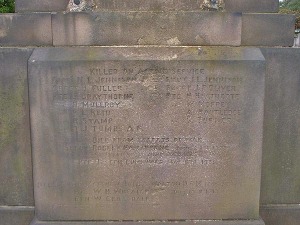
- Belle Vue Zoo’s now vandalised war memorial – luckily the names, although hard to read, are inscribed in stone as the brass statue has been stolen. Image: manchesterhistory.net
- Tracing service men who died after service is more difficult, as they are often not registered on the CWGC site and one for future research in the National Archives medal and pensions records (the ‘burnt documents’) if they have survived.
Tracing service men who died after service is more difficult, as they are often not registered on the CWGC site and one for future research in the National Archives medal and pensions records (the ‘burnt documents’) if they have survived.
There are sadly probably many more names to add to wartime casualty lists from zoos, botanic gardens and aquariums as our World War Zoo gardens research project continues.
We would be interested to hear of any more names or memorials that you know of and haven’t read about in the last 6 years of blogposts.
So buy a poppy (there’s a box in the Newquay Zoo office or shop if you’re visiting) and spare a thought for these men and their families on Remembrance Sunday, and also for the many people not listed who were affected by their war service, men and women not just from Britain but all over the world.
Posted November 2015 by Mark Norris, World War Zoo Gardens project, Newquay Zoo.
53.454118
-2.163298











